I was climbing the mountain together with my friend, going up and on the top of that mountain I can see the woman, she is seller in the oriental shop, it looked like Tibetan spiritual shop, she gives me the stone, it is pink color, very beautiful, over it there is cloth made in Tibetan style, I never seen such stone before. And then the woman says to me, this stone is from Taj Mahal. At the same time my friend tells me " It is God shows to you the way to a Great Love".
Friday, June 24, 2011
"Uprising"
The paranoia is in bloom, the PR
The transmissions will resume
They'll try to push drugs
Keep us all dumbed down and hope that
We will never see the truth around
(So come on!)
Another promise, another scene, another
A package lie not to keep us trapped in greed
With all the green belts wrapped around our minds
And endless red tape to keep the truth confined
(So come on!)
They will not force us
They will stop degrading us
They will not control us
We will be victorious
Interchanging mind control
Come let the revolution take its toll if you could
Flick the switch and open your third eye, you'd see that
We should never be afraid to die
(So come on!)
Rise up and take the power back, it's time that
The fat cats had a heart attack, you know that
Their time is coming to an end
We have to unify and watch our flag ascend
They will not force us
They will stop degrading us
They will not control us
We will be victorious
Hey .. hey ... hey .. hey!
They will not force us
They will stop degrading us
They will not control us
We will be victorious
Hey .. hey ... hey .. hey!
The transmissions will resume
They'll try to push drugs
Keep us all dumbed down and hope that
We will never see the truth around
(So come on!)
Another promise, another scene, another
A package lie not to keep us trapped in greed
With all the green belts wrapped around our minds
And endless red tape to keep the truth confined
(So come on!)
They will not force us
They will stop degrading us
They will not control us
We will be victorious
Interchanging mind control
Come let the revolution take its toll if you could
Flick the switch and open your third eye, you'd see that
We should never be afraid to die
(So come on!)
Rise up and take the power back, it's time that
The fat cats had a heart attack, you know that
Their time is coming to an end
We have to unify and watch our flag ascend
They will not force us
They will stop degrading us
They will not control us
We will be victorious
Hey .. hey ... hey .. hey!
They will not force us
They will stop degrading us
They will not control us
We will be victorious
Hey .. hey ... hey .. hey!
The True Story of the Statue of Liberty.
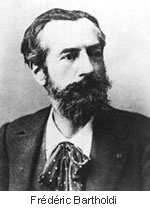 In 1865 a young French sculptor named Frédéric-Auguste Bartholdi [wiki] went to a banquet near the town of Versailles, where he struck up a conversation with Edouard de Laboulaye, a prominent historian.
In 1865 a young French sculptor named Frédéric-Auguste Bartholdi [wiki] went to a banquet near the town of Versailles, where he struck up a conversation with Edouard de Laboulaye, a prominent historian. De Laboulaye, a great admirer of the United States, observed that the country’s centennial was approaching in 1876. He thought it would be a good idea for France to present America with a gift to commemorate the occasion. But what? Bartholdi proposed a giant statue of some kind … and thought about it for the next six years.
COMING TO AMERICA
By 1871, Bartholdi had most of the details worked out in his mind: The American monument would be a colossal statue of a woman called “Liberty Enlightening the World.” It would be paid for by the French people, and the pedestal that it stood on would be financed and built by the Americans.

| Illustration from U.S. Patent D11023, Filed Jan 2, 1870 by Bartholdi. The idea excited him so much that he booked a passage on a ship and sailed to New York to drum up support for it. As he entered New York Harbor, Bartholdi noticed a small, 12-acre piece of land near Ellis Island, called Bedloe’s Island. He decided it was the perfect spot for his statue. Bartholdi spent the next five months traveling around the U.S. and getting support for the statue. Then he went back to France, where the government of Emperor Napoléon III (Napoléon Bonaparte’s nephew) was openly hostile to the democratic and republican ideals celebrated by the Statue of Liberty. They would have jailed him if he’d spoken of the project openly – so Bartholdi kept a low profile until 1874, when the Third Republic was proclaimed after Napoléon III’s defeat in the Franco- 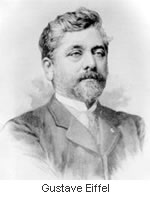 Bartholdi went back to work. He founded a group called the Franco-American Union, comprised of French and American supporters, to help raise money for the statue. He also recruited Alexandre-Gustave Eiffel, soon to become famous for the Eiffel Tower, to design the steel and iron framework to hold the statue up. Bartholdi went back to work. He founded a group called the Franco-American Union, comprised of French and American supporters, to help raise money for the statue. He also recruited Alexandre-Gustave Eiffel, soon to become famous for the Eiffel Tower, to design the steel and iron framework to hold the statue up.A WOMAN IN A HURRY By now the centennial was only two years away. It was obvious that the huge statue couldn’t be designed, financed, built, shipped, and installed on Bedloe’s Island in time for the big celebration. But Bartholdi kept going anyway. Raising the $400,000 he estimated was needed to build the statue in France wasn’t easy. Work stopped frequently when cash ran out, and Bartholdi and his craftspeople missed deadline after deadline. Then in 1880 the Franco-American Union came up with the idea of holding a “Liberty” lottery to raise funds. That did the trick.  Construction of Lady Liberty’s left hand holding the tablet (Image Credit: Album des Travaux de Construction de la Statue Colossale de la Liberte destinee au Port de New-York, 1883 at Statue of Liberty National Monument)  Statue of Liberty being built in Bartholdi’s studio (left, source: NYC Architecture). Head of the Statue of Liberty, exhibited at the 1878 Paris Exposition (right, source: Statue of Liberty Head). In the United States, things were harder. There was some enthusiasm, but not as much as in France. It was, after all, a French statue … and not everyone was sure the country needed a French statue, even for free. The U.S. Congress did vote unanimously to accept the gift from France … but it didn’t provide any funding for the pedestal, and neither did the city of New York. Neither did the state. By now, the Statue of Liberty’s right hand and torch were finished, so Bartholdi shipped it to the Philadelphia Centennial Exhibition and had it put on display. For a fee of 50¢, visitors could climb a 30-foot steel ladder up the side of the hand and stand on the balcony surrounding the torch. Two years later the statue’s head was displayed in a similar fashion in Paris, giving people a chance to climb up into the head and peek out from the windows in the crown. But while events like these generated a lot of enthusiasm, they didn’t raise as much money as Bartholdi hoped for. LADY’S MAN 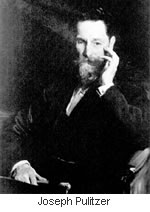 In 1883 the U.S. Congress voted down a fresh attempt to provide $100,000 toward the cost of the pedestal; the vote so outraged Joseph Pulitzer, publisher of the New York World, that he launched a campaign in the pages of his newspaper to raise the money. In 1883 the U.S. Congress voted down a fresh attempt to provide $100,000 toward the cost of the pedestal; the vote so outraged Joseph Pulitzer, publisher of the New York World, that he launched a campaign in the pages of his newspaper to raise the money.“The Bartholdi statue will soon be on its way to enlighten the world,” he told his readers, “more appropriate would be the gift of a statue of parsimony than a statue of liberty, if this is the appreciation we show of a friendly nation’s sentiment and generosity.” After two months of non-stop haranguing, he managed to raise exactly $135.75 of the $200,000 needed to build the pedestal. NOTHING TO STAND ON In June of 1884, work on the statue itself was finished. Bartholdi had erected it in a courtyard next to his studio in Paris. The original plan had been to dismantle it as soon as it was completed, pack it into shipping crates, and send it to the United States, where it would be installed atop the pedestal on Bedloe’s Island … But the pedestal wasn’t even close to being finished. So Bartholdi left the statue standing in the courtyard. In September 1884 work on the pedestal ground to a halt when the project ran out of money. An estimated $100,000 was still needed. When it appeared that New York was coming up empty-handed, Boston, Cleveland, Philadelphia, and San Francisco began to compete to have the Statue of Liberty built in their cities. IF AT FIRST YOU DON’T SUCCEED … Furious, Joseph Pulitzer decided to try again. In the two years since his first campaign, his newspaper’s circulation had grown from a few thousand readers to more than 100,000. He hoped that now his paper was big enough to make a difference. For more than five months, beginning on March 16, 1885, Pulitzer beseeched his readers day after day to send in what they could. No reader was too humble, no donation too small; every person who contributed would receive a mention in the newspaper. “The statue is not a gift from the millionaires of France to the millionaires of America,” he told readers, “but a gift of the whole people of France to the whole people of America. Take this appeal to yourself personally.” This time, the campaign began to get results: By March 27, 2,535 people had contributed $2,359.67. Then on April 1, Pulitzer announced that the ship containing the crated parts of the statue would leave France aboard the French warship Isere on May 8th. The excitement began to build, prompting a new wave of giving. By April 15, he’d raised $25,000, and a month later another $25,000 – enough money to restart work on the pedestal. At this point, the makers of Castoria laxative stepped forward to help. They offered to chip in $25,000, “provided that for the period of one year, you permit us to place across the top of the pedestal the word ‘Castoria.,’” they wrote. “Thus art and science, the symbol of liberty to man, and of health to his children, would more closely enshrined in the hearts of our people.” The offer of a laxative for Miss Liberty was politely declined; Castoria kept its money. ON A ROLL By now the race to fund the pedestal had captivated the entire country, and money really began to pour in. People sent in pennies, nickels and dimes … and they also began buying copies of the World each day to keep track of the race; by the time the dust settled, the World’s circulation had exploded to the point that it was the most widely-read newspaper in the entire Western hemisphere. On June 19, the fundraising passed the $75,000 mark; on July 22, the Isere arrived in New York Harbor and began unloading its cargo; bringing the excitement – and the giving – to its peak. Finally on August 11, Pulitzer’s goal was met. “ONE HUNDRED THOUSAND DOLLARS! TRIUMPHANT COMPLETION OF THE WORLD‘S FUND FOR THE LIBERTY PEDESTAL.” More than 120,000 people had contributed to the effort, for an average donation of about 83¢ per person. Work on the pedestal now moved at a steady clip; by April 1886 it was finished, and the pieces of the statue itself were put into place. The internal steel and iron framework structure went up first; then the pieces of the statue’s outer skin were attached one by one. Finally on October 28, 1886, at a ceremony headed by President Grover Cleveland, the statue was opened to the public … more than ten years after the original July 4, 1876 deadline. The statue was late – very late. But better late than never. 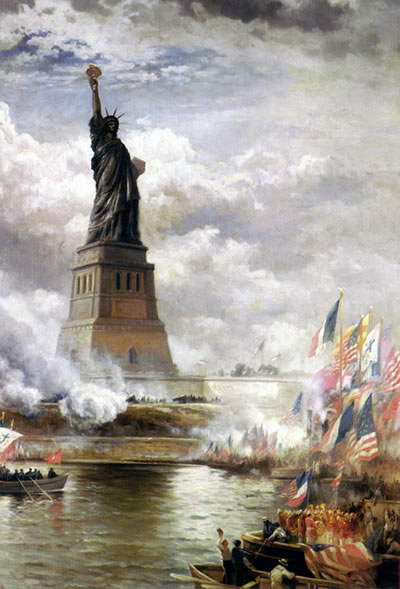 The Statue of Liberty Enlightening the World (1886) by Edward Moran. A WOMAN OF FEW WORDS 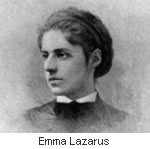 The verse most closely associated with the statue, “Give me your tired, your poor, / Your huddled masses yearning to breathe free …” weren’t added to the pedestal until 1903 … and only after officials realized what an inspiration the statue had become to the waves of immigrants arriving at nearby Ellis Island. The verses are part of “The New Colossus,” a sonnet composed by New York poet Emma Lazarus in 1883; she donated it to an auction at the New York’s Academy of Design to raise money for the statue’s pedestal. The verse most closely associated with the statue, “Give me your tired, your poor, / Your huddled masses yearning to breathe free …” weren’t added to the pedestal until 1903 … and only after officials realized what an inspiration the statue had become to the waves of immigrants arriving at nearby Ellis Island. The verses are part of “The New Colossus,” a sonnet composed by New York poet Emma Lazarus in 1883; she donated it to an auction at the New York’s Academy of Design to raise money for the statue’s pedestal.http://www.youtube.com/watch?v=_EBmXX4OzQQ&feature=player_embedded http://www.neatorama.com/2007/05/31/the-true-story-of-the-statue-of-liberty/ | |
Subscribe to:
Comments (Atom)
